seats RENAULT KANGOO 2017 X61 / 2.G User Guide
[x] Cancel search | Manufacturer: RENAULT, Model Year: 2017, Model line: KANGOO, Model: RENAULT KANGOO 2017 X61 / 2.GPages: 260, PDF Size: 5.68 MB
Page 42 of 260
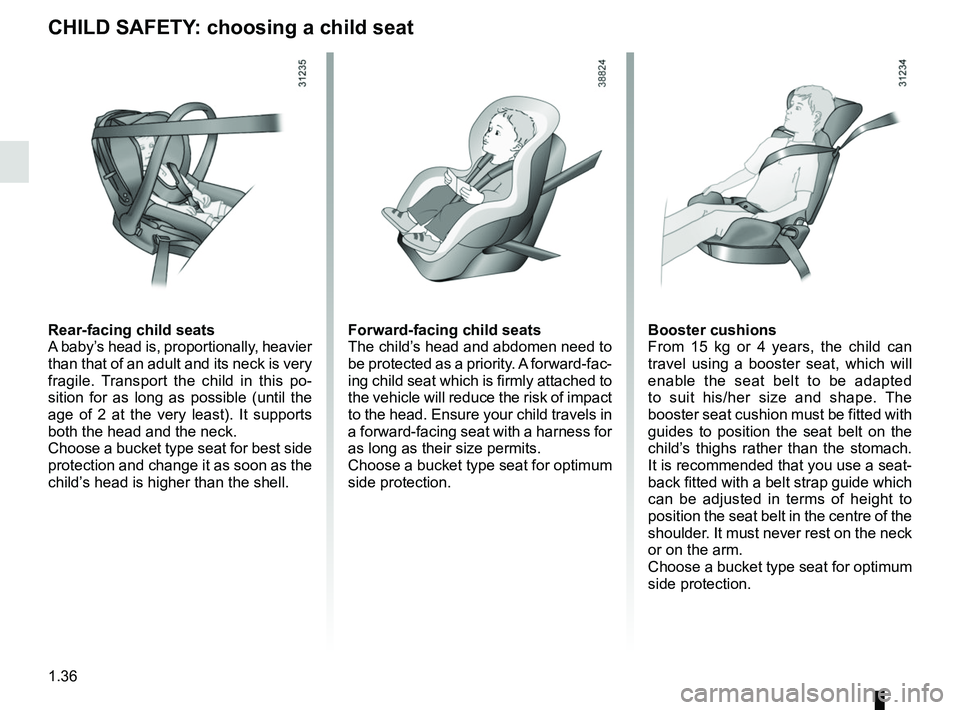
1.36
CHILD SAFETY: choosing a child seat
Rear-facing child seats
A baby’s head is, proportionally, heavier
than that of an adult and its neck is very
fragile. Transport the child in this po-
sition for as long as possible (until the
age of 2 at the very least). It supports
both the head and the neck.
Choose a bucket type seat for best side
protection and change it as soon as the
child’s head is higher than the shell.Forward-facing child seats
The child’s head and abdomen need to
be protected as a priority. A forward-fac-
ing child seat which is firmly attached to
the vehicle will reduce the risk of impact
to the head. Ensure your child travels in
a forward-facing seat with a harness for
as long as their size permits.
Choose a bucket type seat for optimum
side protection.Booster cushions
From 15 kg or 4 years, the child can
travel using a booster seat, which will
enable the seat belt to be adapted
to suit his/her size and shape. The
booster seat cushion must be fitted with
guides to position the seat belt on the
child’s thighs rather than the stomach.
It is recommended that you use a seat-
back fitted with a belt strap guide which
can be adjusted in terms of height to
position the seat belt in the centre of the
shoulder. It must never rest on the neck
or on the arm.
Choose a bucket type seat for optimum
side protection.
Page 43 of 260
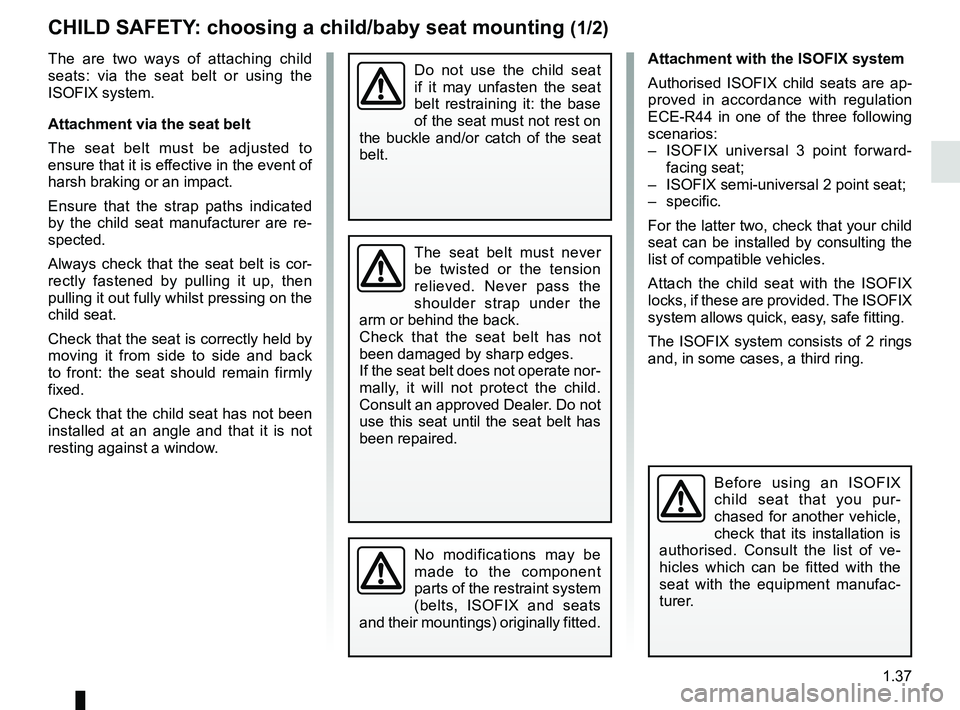
1.37
CHILD SAFETY: choosing a child/baby seat mounting (1/2)
The are two ways of attaching child
seats: via the seat belt or using the
ISOFIX system.
Attachment via the seat belt
The seat belt must be adjusted to
ensure that it is effective in the event of
harsh braking or an impact.
Ensure that the strap paths indicated
by the child seat manufacturer are re-
spected.
Always check that the seat belt is cor-
rectly fastened by pulling it up, then
pulling it out fully whilst pressing on the
child seat.
Check that the seat is correctly held by
moving it from side to side and back
to front: the seat should remain firmly
fixed.
Check that the child seat has not been
installed at an angle and that it is not
resting against a window.Attachment with the ISOFIX system
Authorised ISOFIX child seats are ap-
proved in accordance with regulation
ECE-R44 in one of the three following
scenarios:
– ISOFIX universal 3 point forward-
facing seat;
– ISOFIX semi-universal 2 point seat;
– specific.
For the latter two, check that your child
seat can be installed by consulting the
list of compatible vehicles.
Attach the child seat with the ISOFIX
locks, if these are provided. The ISOFIX
system allows quick, easy, safe fitting.
The ISOFIX system consists of 2 rings
and, in some cases, a third ring.
Before using an ISOFIX
child seat that you pur-
chased for another vehicle,
check that its installation is
authorised. Consult the list of ve-
hicles which can be fitted with the
seat with the equipment manufac-
turer.
No modifications may be
made to the component
parts of the restraint system
(belts, ISOFIX and seats
and their mountings) originally fitted.
The seat belt must never
be twisted or the tension
relieved. Never pass the
shoulder strap under the
arm or behind the back.
Check that the seat belt has not
been damaged by sharp edges.
If the seat belt does not operate nor-
mally, it will not protect the child.
Consult an approved Dealer. Do not
use this seat until the seat belt has
been repaired.
Do not use the child seat
if it may unfasten the seat
belt restraining it: the base
of the seat must not rest on
the buckle and/or catch of the seat
belt.
Page 44 of 260
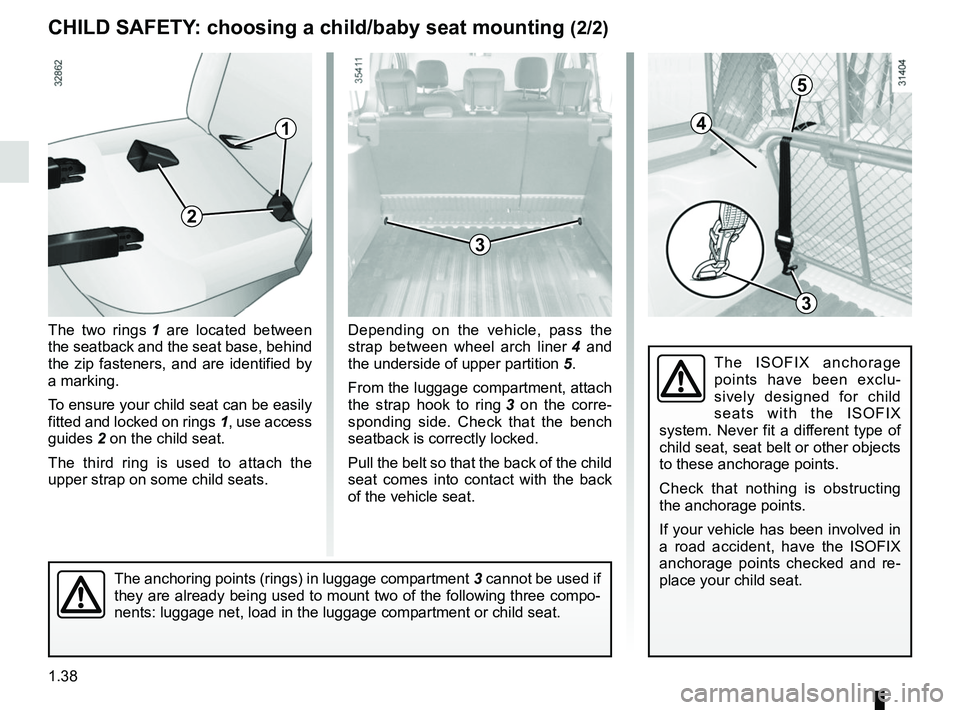
1.38
The two rings 1 are located between
the seatback and the seat base, behind
the zip fasteners, and are identified by
a marking.
To ensure your child seat can be easily
fitted and locked on rings 1, use access
guides 2 on the child seat.
The third ring is used to attach the
upper strap on some child seats.
3
CHILD SAFETY: choosing a child/baby seat mounting (2/2)
Depending on the vehicle, pass the
strap between wheel arch liner 4 and
the underside of upper partition 5.
From the luggage compartment, attach
the strap hook to ring 3 on the corre-
sponding side. Check that the bench
seatback is correctly locked.
Pull the belt so that the back of the child
seat comes into contact with the back
of the vehicle seat.
The ISOFIX anchorage
points have been exclu-
sively designed for child
seats with the ISOFIX
system. Never fit a different type of
child seat, seat belt or other objects
to these anchorage points.
Check that nothing is obstructing
the anchorage points.
If your vehicle has been involved in
a road accident, have the ISOFIX
anchorage points checked and re-
place your child seat.
The anchoring points (rings) in luggage compartment 3 cannot be used if
they are already being used to mount two of the following three compo-
nents: luggage net, load in the luggage compartment or child seat.
4
5
3
1
2
Page 45 of 260
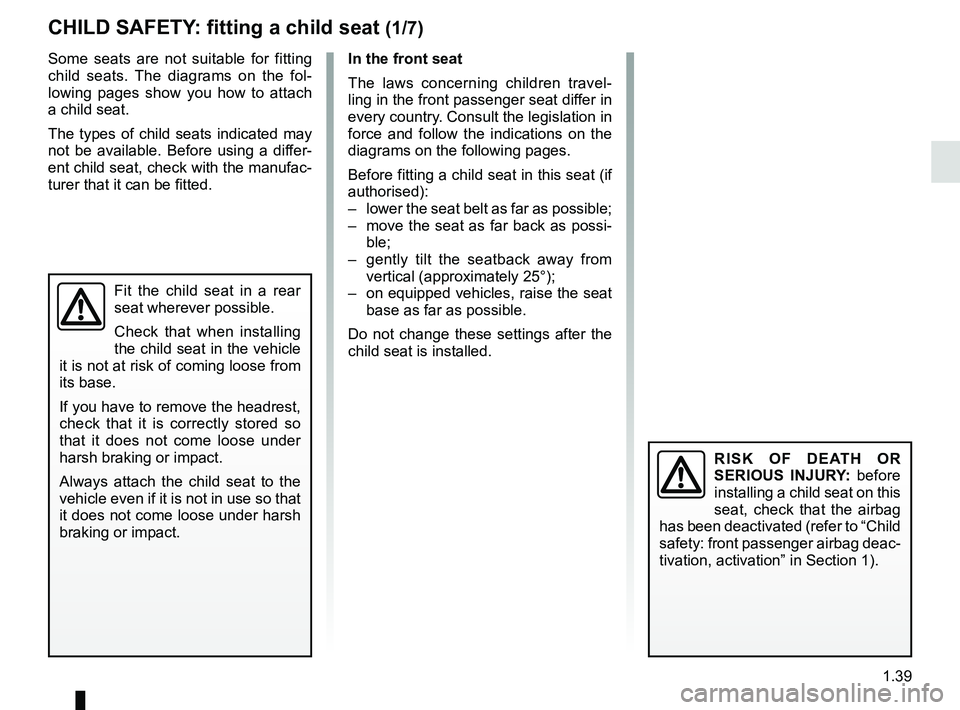
1.39
Some seats are not suitable for fitting
child seats. The diagrams on the fol-
lowing pages show you how to attach
a child seat.
The types of child seats indicated may
not be available. Before using a differ-
ent child seat, check with the manufac-
turer that it can be fitted.
CHILD SAFETY: fitting a child seat (1/7)
In the front seat
The laws concerning children travel-
ling in the front passenger seat differ in
every country. Consult the legislation in
force and follow the indications on the
diagrams on the following pages.
Before fitting a child seat in this seat (if
authorised):
– lower the seat belt as far as possible;
– move the seat as far back as possi-ble;
– gently tilt the seatback away from vertical (approximately 25°);
– on equipped vehicles, raise the seat base as far as possible.
Do not change these settings after the
child seat is installed.
RISK OF DEATH OR
SERIOUS INJURY: before
installing a child seat on this
seat, check that the airbag
has been deactivated (refer to “Child
safety: front passenger airbag deac-
tivation, activation” in Section 1).
Fit the child seat in a rear
seat wherever possible.
Check that when installing
the child seat in the vehicle
it is not at risk of coming loose from
its base.
If you have to remove the headrest,
check that it is correctly stored so
that it does not come loose under
harsh braking or impact.
Always attach the child seat to the
vehicle even if it is not in use so that
it does not come loose under harsh
braking or impact.
Page 46 of 260
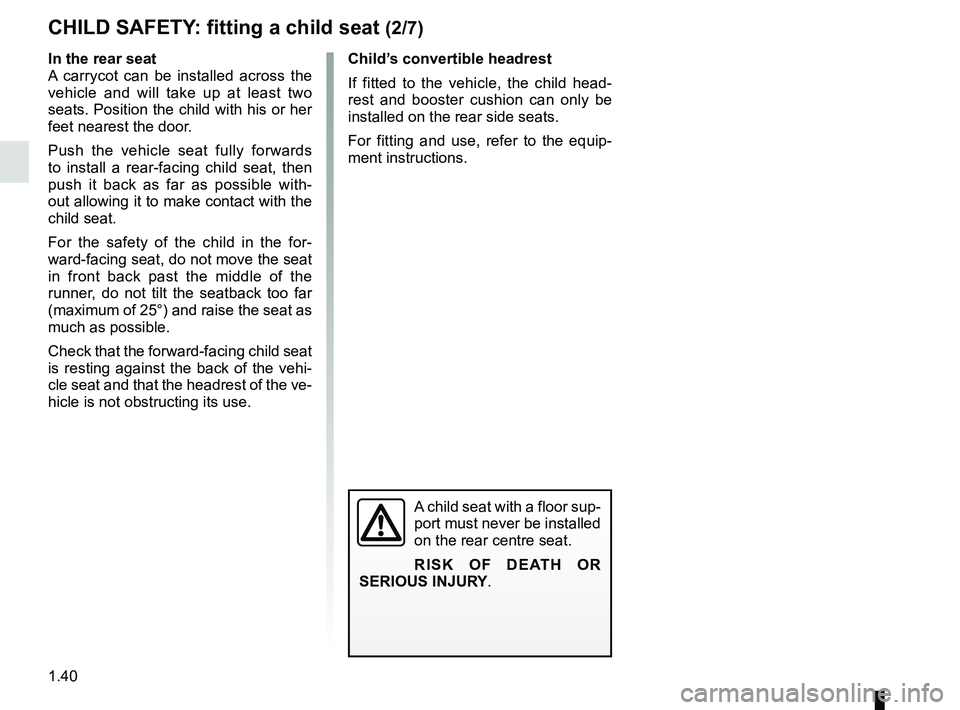
1.40
In the rear seat
A carrycot can be installed across the
vehicle and will take up at least two
seats. Position the child with his or her
feet nearest the door.
Push the vehicle seat fully forwards
to install a rear-facing child seat, then
push it back as far as possible with-
out allowing it to make contact with the
child seat.
For the safety of the child in the for-
ward-facing seat, do not move the seat
in front back past the middle of the
runner, do not tilt the seatback too far
(maximum of 25°) and raise the seat as
much as possible.
Check that the forward-facing child seat
is resting against the back of the vehi-
cle seat and that the headrest of the ve-
hicle is not obstructing its use.
CHILD SAFETY: fitting a child seat (2/7)
A child seat with a floor sup-
port must never be installed
on the rear centre seat.
RISK OF DEATH OR
SERIOUS INJURY.
Child’s convertible headrest
If fitted to the vehicle, the child head-
rest and booster cushion can only be
installed on the rear side seats.
For fitting and use, refer to the equip-
ment instructions.
Page 47 of 260
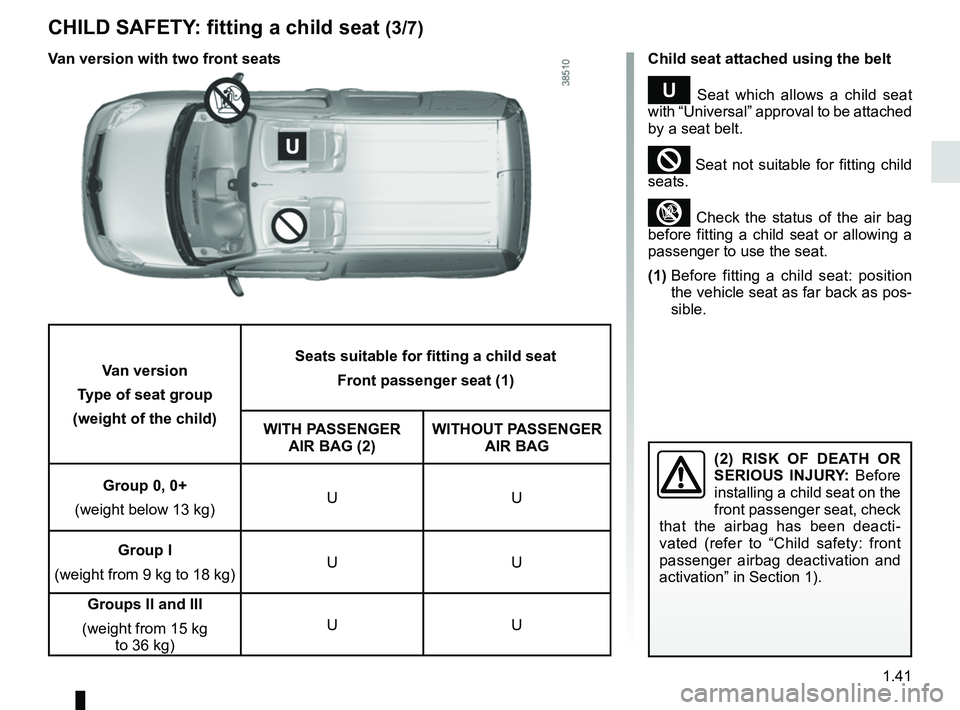
1.41
CHILD SAFETY: fitting a child seat (3/7)
Child seat attached using the belt
¬ Seat which allows a child seat
with “Universal” approval to be attached
by a seat belt.
² Seat not suitable for fitting child
seats.
³ Check the status of the air bag
before fitting a child seat or allowing a
passenger to use the seat.
(1) Before fitting a child seat: position
the vehicle seat as far back as pos-
sible.
Van version
Type of seat group
(weight of the child) Seats suitable for fitting a child seat
Front passenger seat (1)
WITH PASSENGER AIR BAG (2) WITHOUT PASSENGER
AIR BAG
Group 0, 0+
(weight below 13 kg) UU
Group I
(weight from 9 kg to 18 kg) UU
Groups II and III
(weight from 15 kg to 36 kg) UU
(2) RISK OF DEATH OR
SERIOUS INJURY: Before
installing a child seat on the
front passenger seat, check
that the airbag has been deacti-
vated (refer to “Child safety: front
passenger airbag deactivation and
activation” in Section 1).
Van version with two front seats
Page 48 of 260
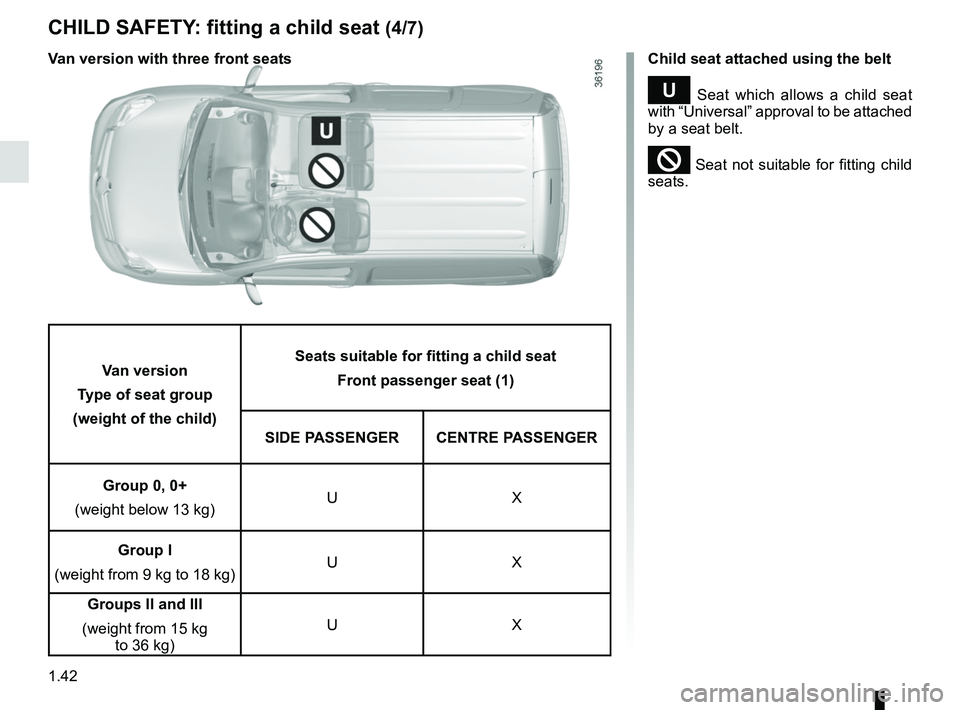
1.42
CHILD SAFETY: fitting a child seat (4/7)
Child seat attached using the belt
¬ Seat which allows a child seat
with “Universal” approval to be attached
by a seat belt.
² Seat not suitable for fitting child
seats.
Van version
Type of seat group
(weight of the child) Seats suitable for fitting a child seat
Front passenger seat (1)
SIDE PASSENGER CENTRE PASSENGER
Group 0, 0+
(weight below 13 kg) UX
Group I
(weight from 9 kg to 18 kg) UX
Groups II and III
(weight from 15 kg to 36 kg) UX
Van version with three front seats
Page 49 of 260
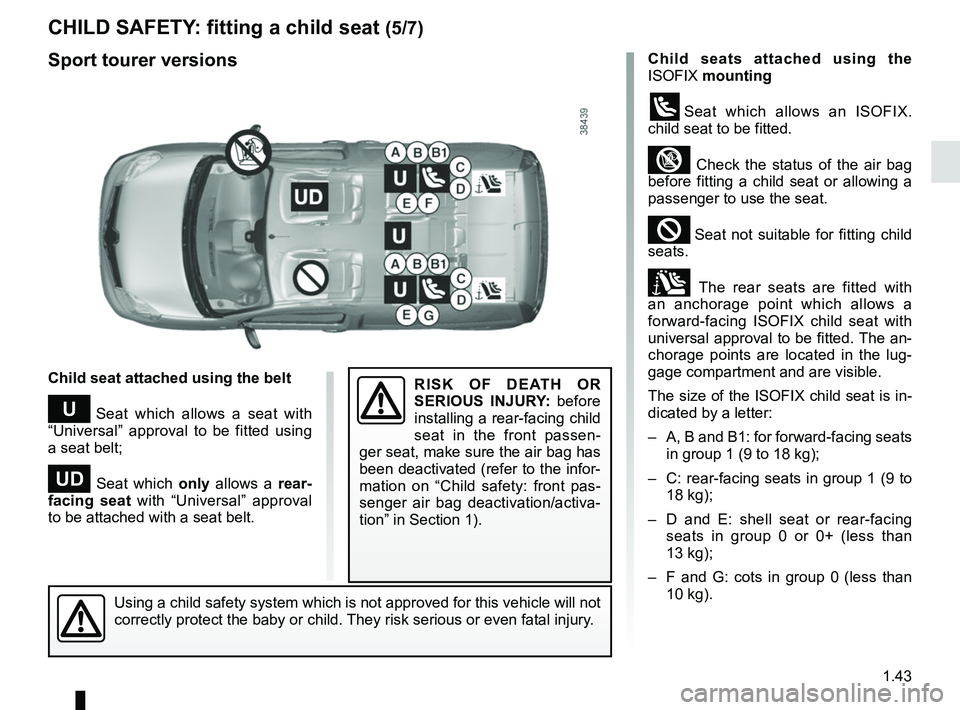
1.43
CHILD SAFETY: fitting a child seat (5/7)
Child seats attached using the
ISOFIX mounting
üSeat which allows an ISOFIX.
child seat to be fitted.
³ Check the status of the air bag
before fitting a child seat or allowing a
passenger to use the seat.
² Seat not suitable for fitting child
seats.
± The rear seats are fitted with
an anchorage point which allows a
forward-facing ISOFIX child seat with
universal approval to be fitted. The an-
chorage points are located in the lug-
gage compartment and are visible.
The size of the ISOFIX child seat is in-
dicated by a letter:
– A, B and B1: for forward-facing seats in group 1 (9 to 18 kg);
– C: rear-facing seats in group 1 (9 to 18 kg);
– D and E: shell seat or rear-facing seats in group 0 or 0+ (less than
13 kg);
– F and G: cots in group 0 (less than 10 kg).
Child seat attached using the belt
¬ Seat which allows a seat with
“Universal” approval to be fitted using
a seat belt;
− Seat which only allows a rear-
facing seat with “Universal” approval
to be attached with a seat belt.
Using a child safety system which is not approved for this vehicle will \
not
correctly protect the baby or child. They risk serious or even fatal injury.
RISK OF DEATH OR
SERIOUS INJURY: before
installing a rear-facing child
seat in the front passen-
ger seat, make sure the air bag has
been deactivated (refer to the infor-
mation on “Child safety: front pas-
senger air bag deactivation/activa-
tion” in Section 1).
Sport tourer versions
Page 50 of 260
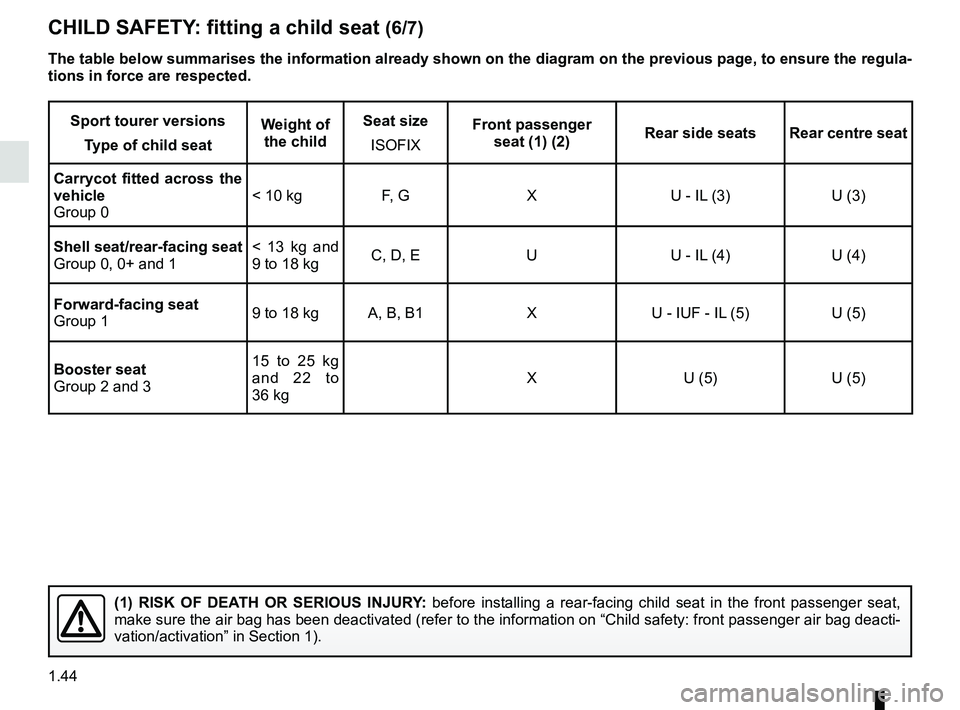
1.44
CHILD SAFETY: fitting a child seat (6/7)
Sport tourer versionsType of child seat Weight of
the child Seat size
ISOFIX Front passenger
seat (1) (2) Rear side seats Rear centre seat
Carrycot fitted across the
vehicle
Group 0 < 10 kg F, G X U - IL (3) U (3)
Shell seat/rear-facing seat
Group 0, 0+ and 1 < 13 kg and
9 to 18 kg
C, D, E U U - IL (4) U (4)
Forward-facing seat
Group 1 9 to 18 kg A, B, B1 X U - IUF - IL (5) U (5)
Booster seat
Group 2 and 3 15 to 25 kg
and 22 to
36 kg
X U (5) U (5)
(1) RISK OF DEATH OR SERIOUS INJURY:
before installing a rear-facing child seat in the front passenger seat,\
make sure the air bag has been deactivated (refer to the information on\
“Child safety: front passenger air bag deacti-
vation/activation” in Section 1).
The table below summarises the information already shown on the diagram \
on the previous page, to ensure the regula-
tions in force are respected.
Page 51 of 260
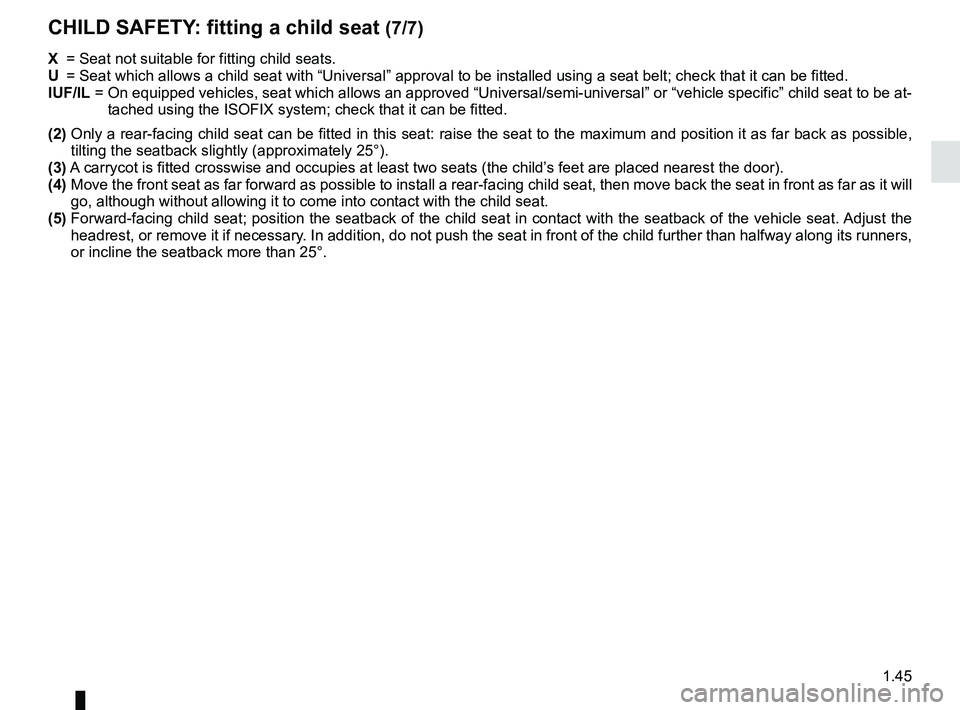
1.45
X = Seat not suitable for fitting child seats.
U = Seat which allows a child seat with “Universal” approval to be ins\
talled using a seat belt; check that it can be fitted.
IUF/IL = On equipped vehicles, seat which allows an approved “Universal/semi-u\
niversal” or “vehicle specific” child seat to be at-
tached using the ISOFIX system; check that it can be fitted.
(2) Only a rear-facing child seat can be fitted in this seat: raise the seat\
to the maximum and position it as far back as possible ,
tilting the seatback slightly (approximately 25°).
(3) A carrycot is fitted crosswise and occupies at least two seats (the chil\
d’s feet are placed nearest the door).
(4) Move the front seat as far forward as possible to install a rear-facing \
child seat, then move back the seat in front as far as it will
go, although without allowing it to come into contact with the child sea\
t.
(5) Forward-facing child seat; position the seatback of the child seat in co\
ntact with the seatback of the vehicle seat. Adjust the
headrest, or remove it if necessary. In addition, do not push the seat in front of the child further than h\
alfway along its runners,
or incline the seatback more than 25°.
CHILD SAFETY: fitting a child seat (7/7)